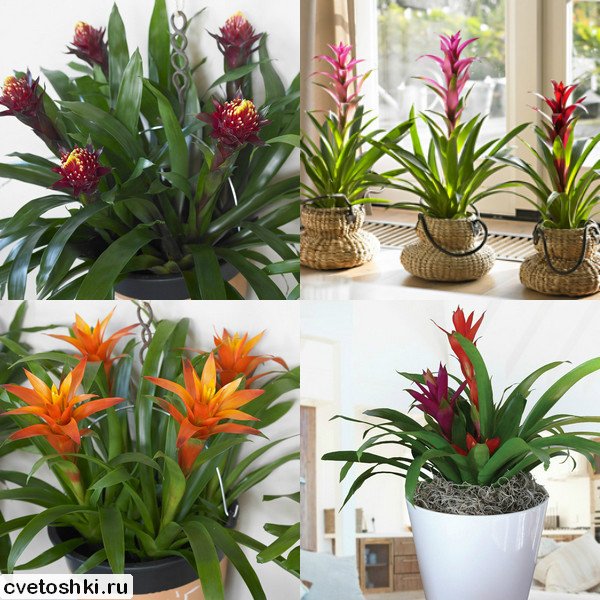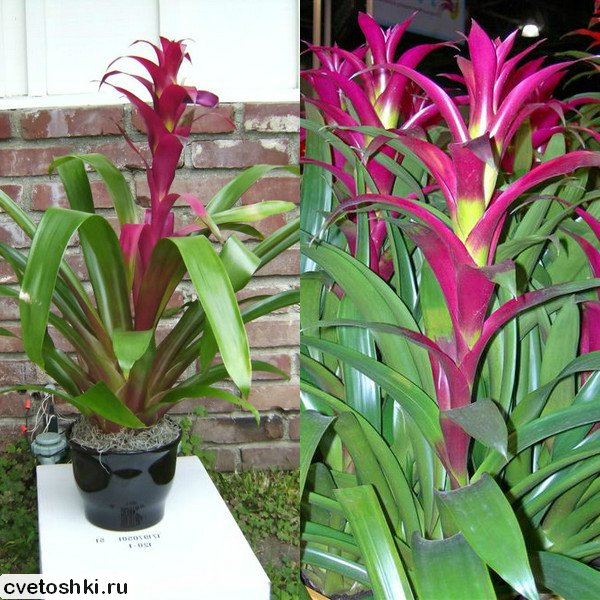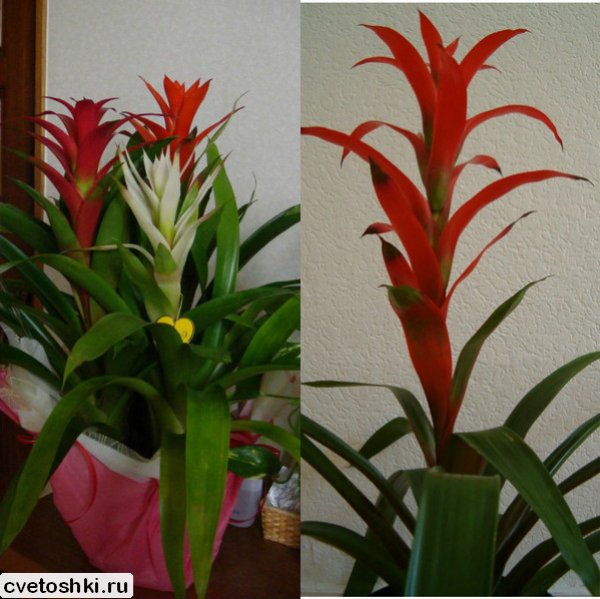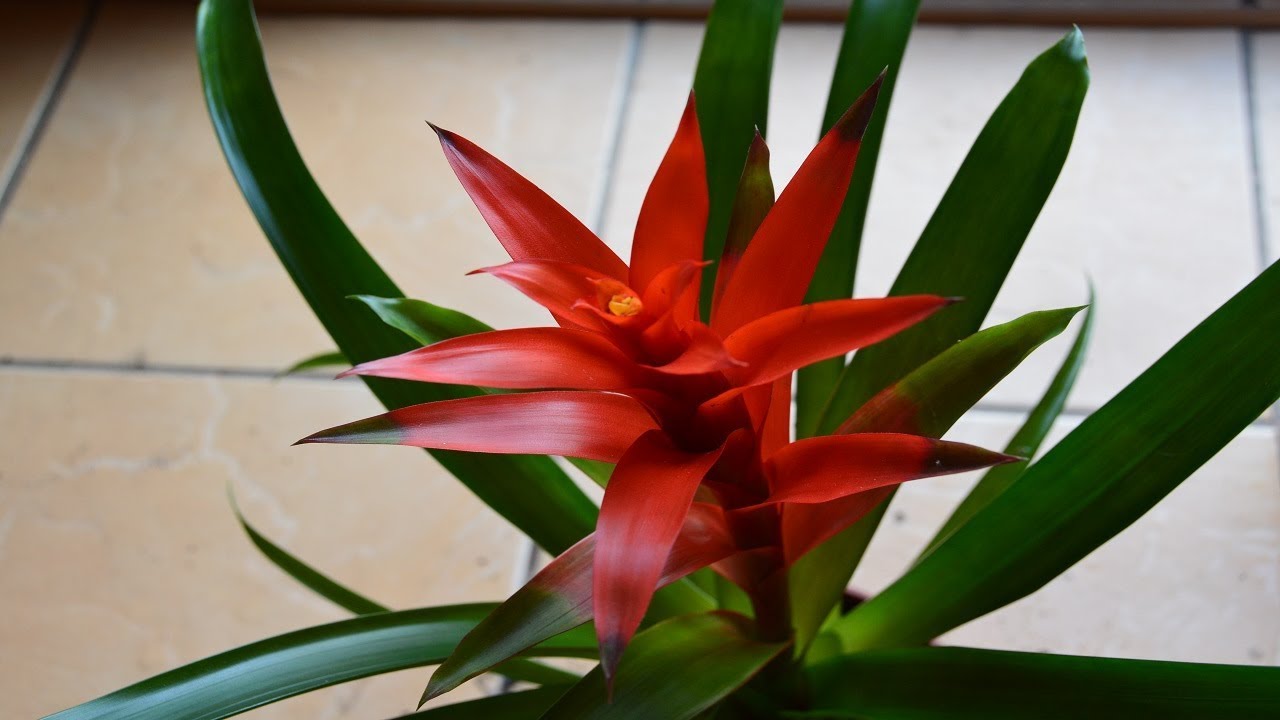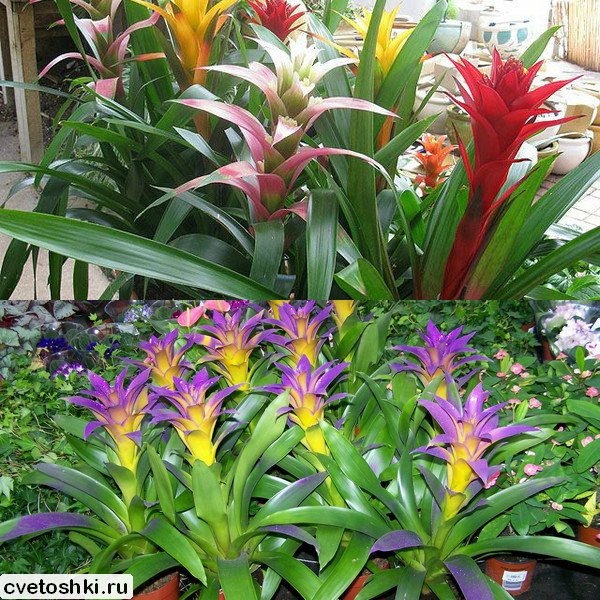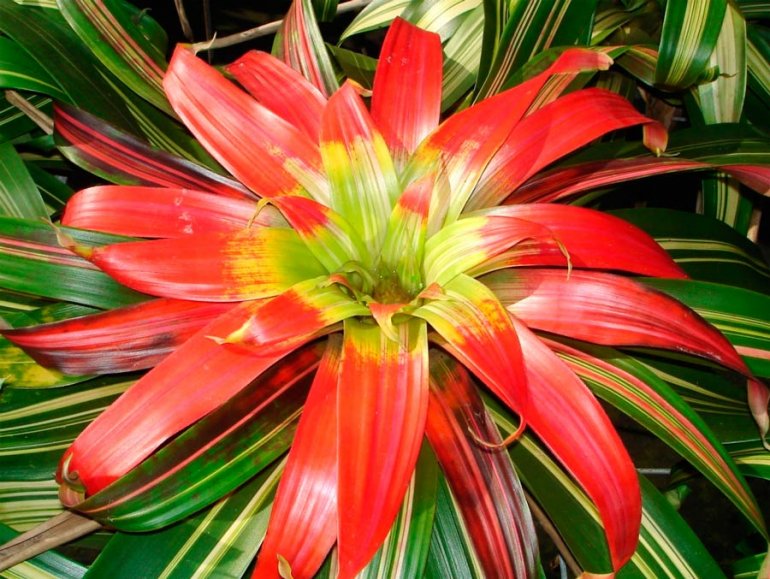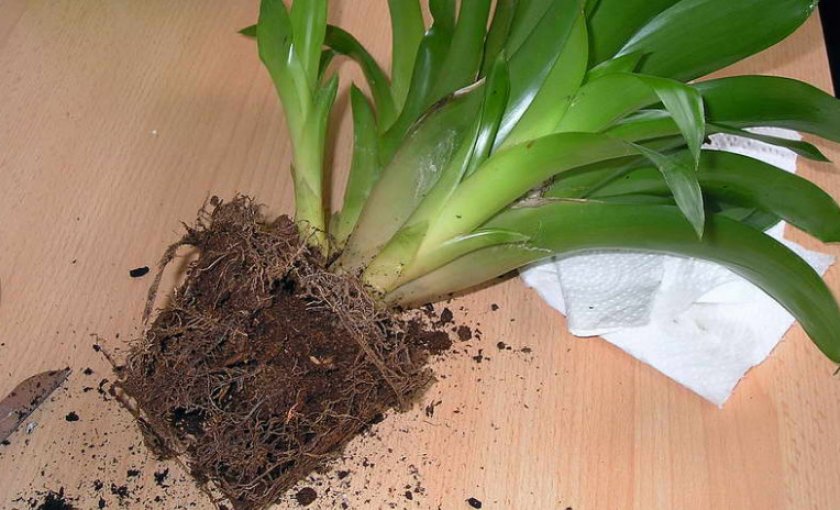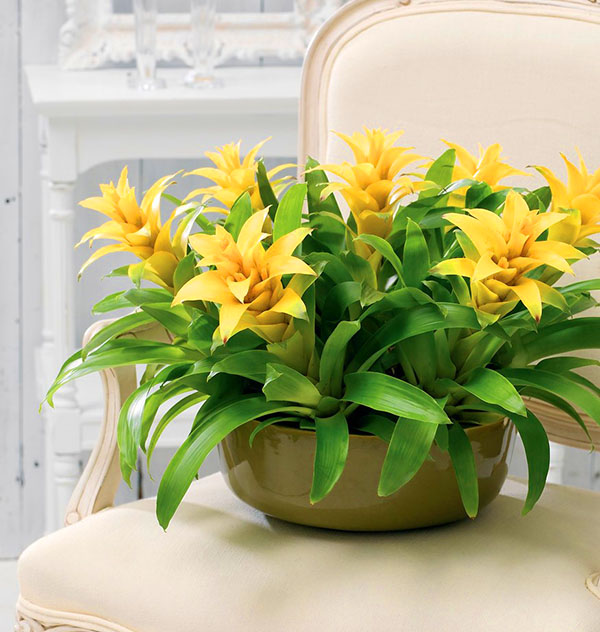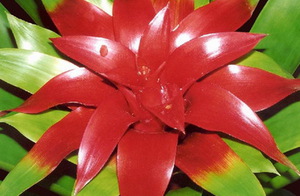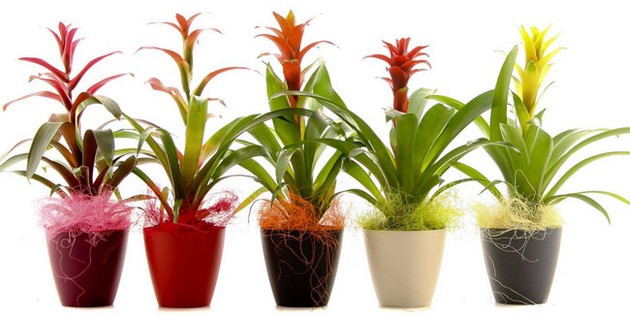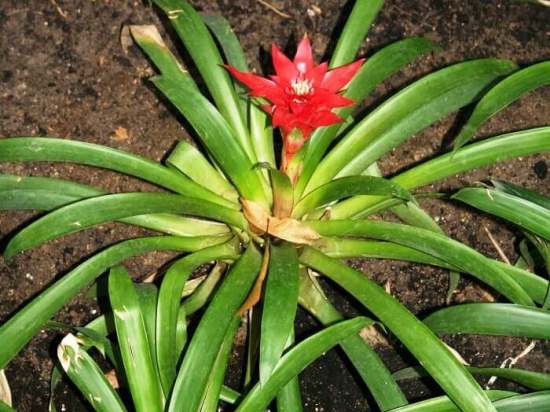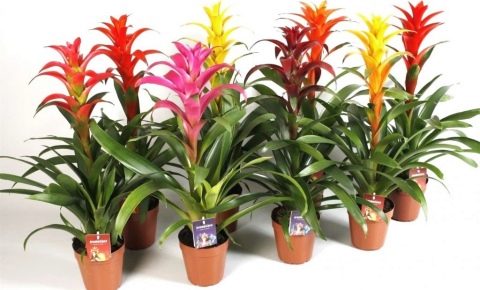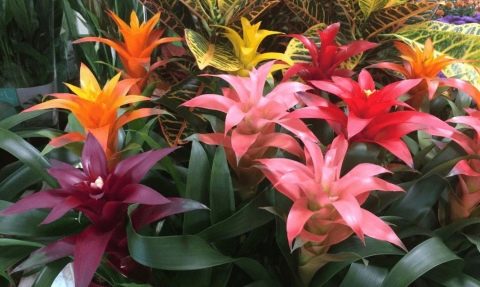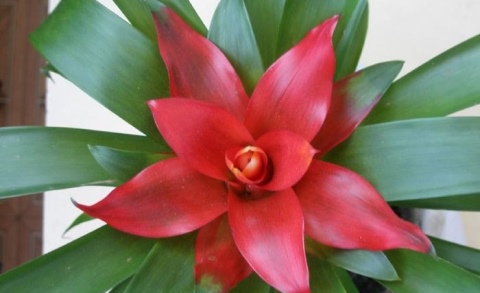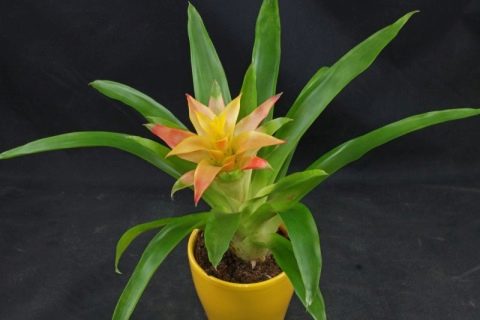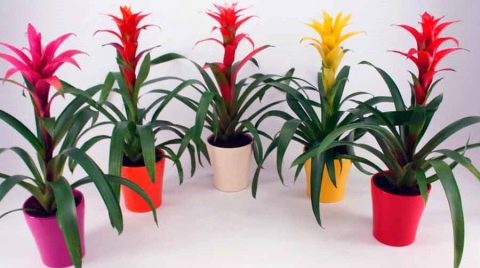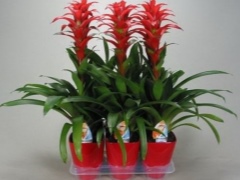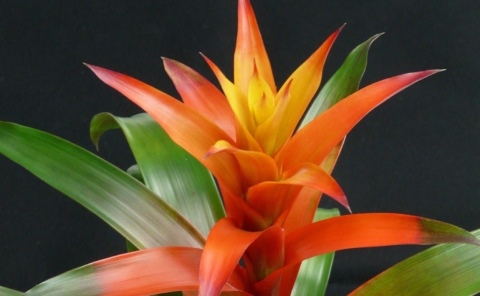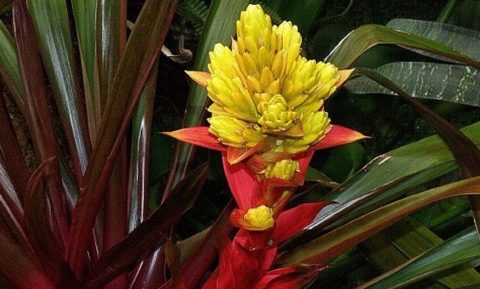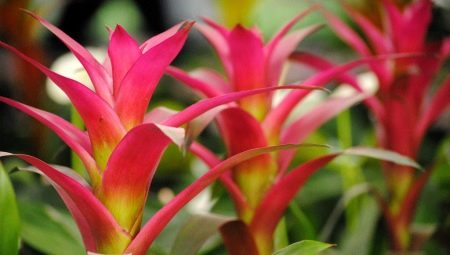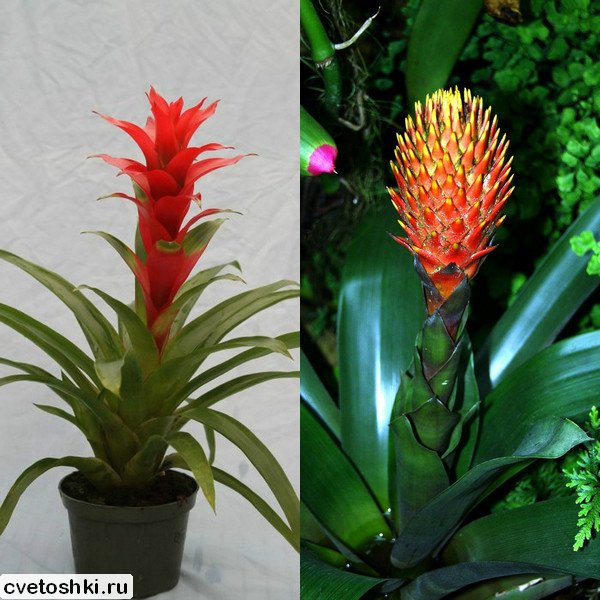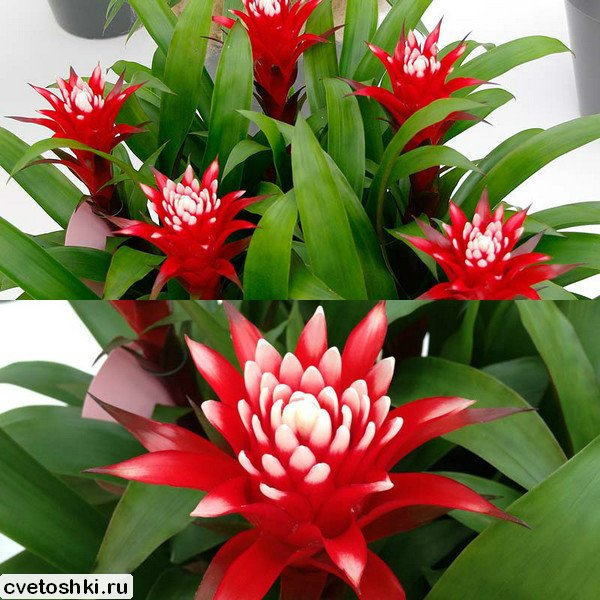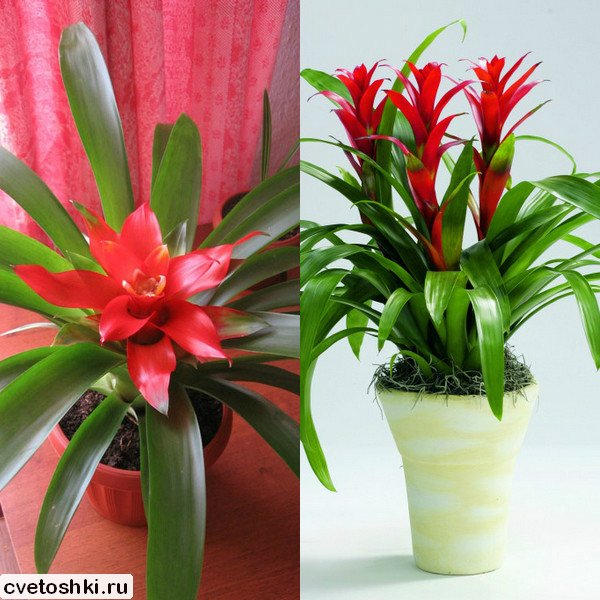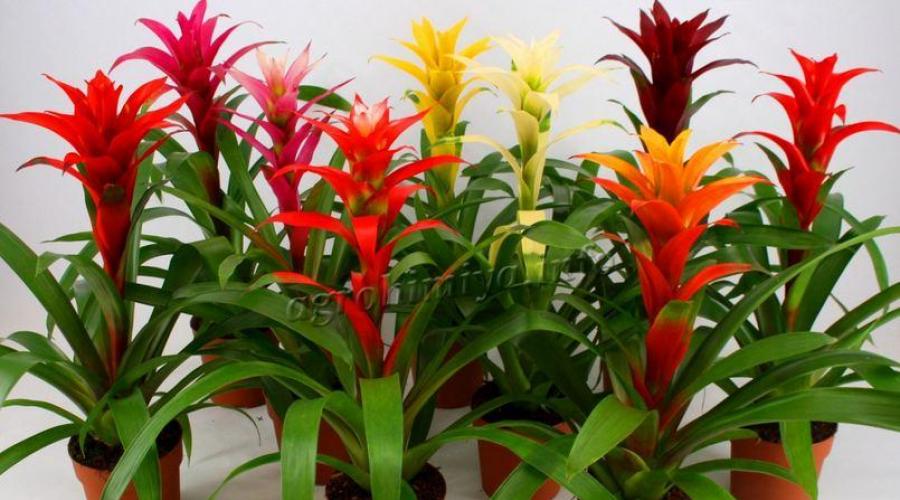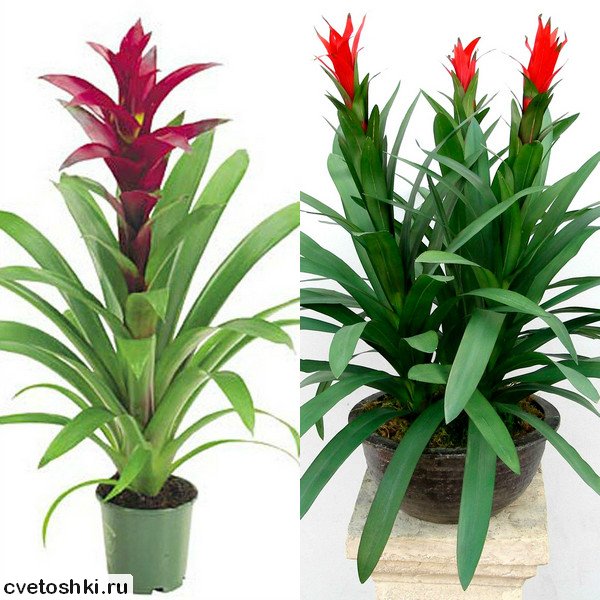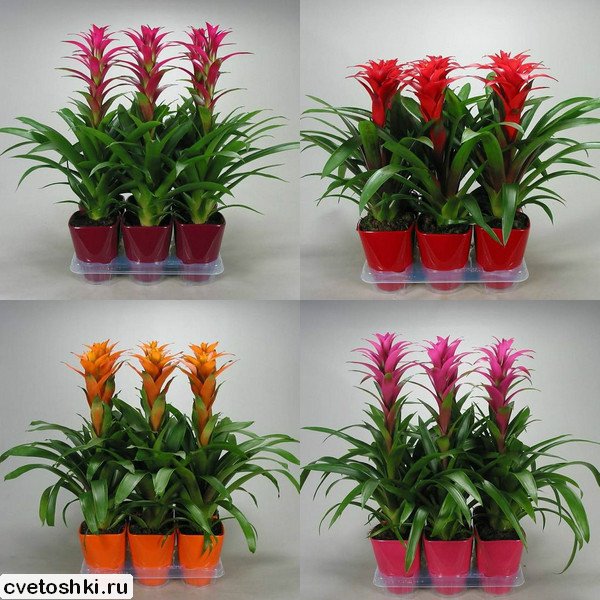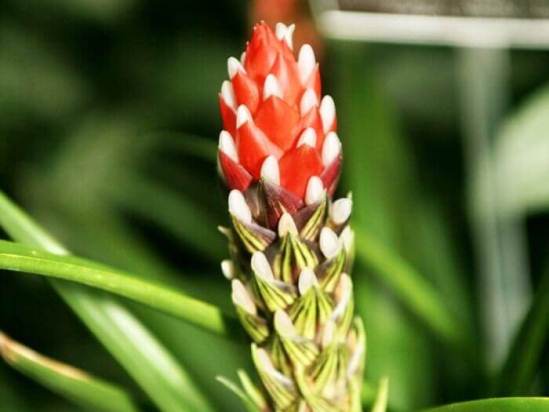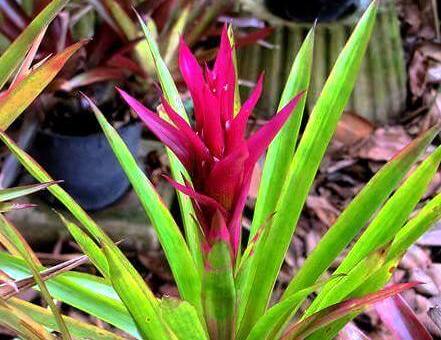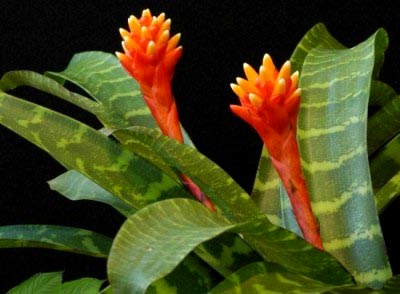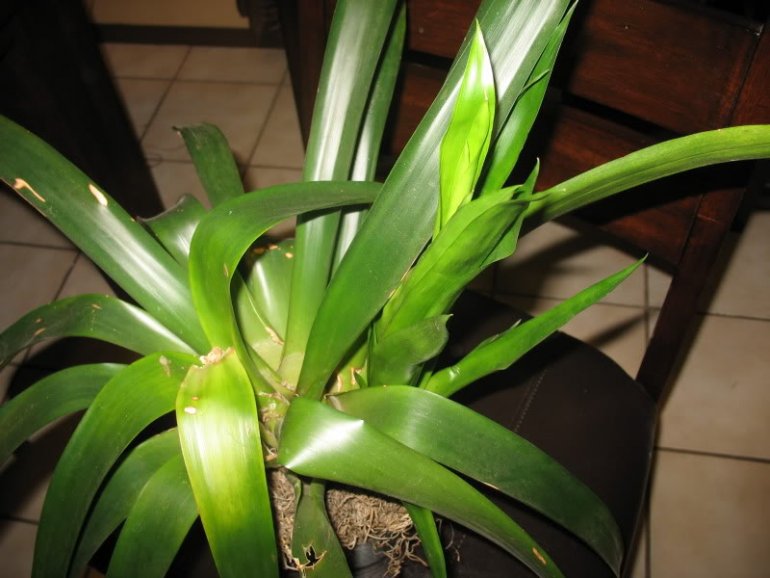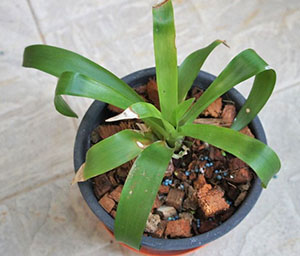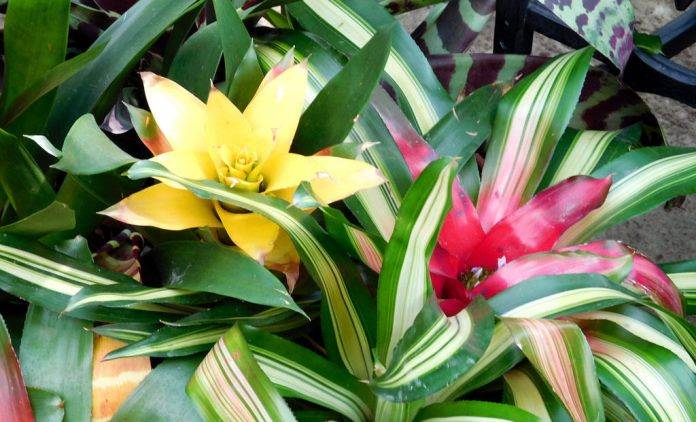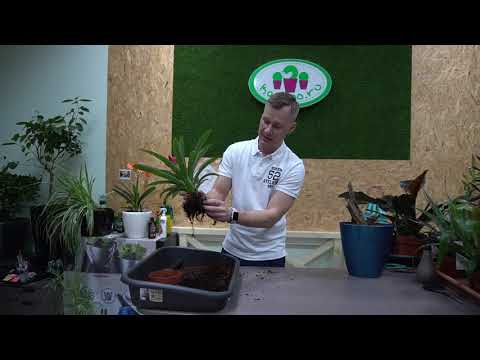Secrets of caring for gusmania at home
After buying a gusmania, you do not need to rush to transplant it into a stationary pot. Let the plant remain for some time in the one in which it was purchased. If the flower is large, after a couple of weeks it will still have to be transplanted into a wider and shallower pot. A gusmania transplant should be carried out carefully, trying not to injure the delicate roots.
Gusmania is installed on a well-lit window sill shaded from the sun. On the sill of the southern orientation, the flowers will be brighter than the northern one. Direct sun is undesirable, as it can burn the leaves. It is advisable to keep the temperature for gusmania moderate throughout the year: in winter 16-18 ° C, in summer a little higher - 18-24 ° C. At a higher temperature, gusmania should be sprayed with settled warm water.
Pour gusmania into a leaf outlet, filling it 2-3 cm with soft rain water. The old water is drained and fresh water is poured every week. The soil in the pot is moistened only after it dries. Waterlogging is more dangerous for Gusmania than drought. In winter, when the temperature drops to 18 ° C, water is drained from the outlets, as it can cause leaves to rot.
The plant is fed monthly all year round with liquid fertilizer for bromeliads. The gusmania rosette is filled with the same solution, the substrate is moistened and the leaves are sprayed. In the summer, salts are washed out of the pot twice.
The peculiarity of the flowering of gusmania is that after the bracts wilt, the plant dies, leaving small shoots at the base of the leaves, with which the flower further propagates. When the shoots grow to a height of 14 cm, they are separated from the plant with a sharp knife and transplanted into small (up to 15 cm in diameter) containers, wide and low.
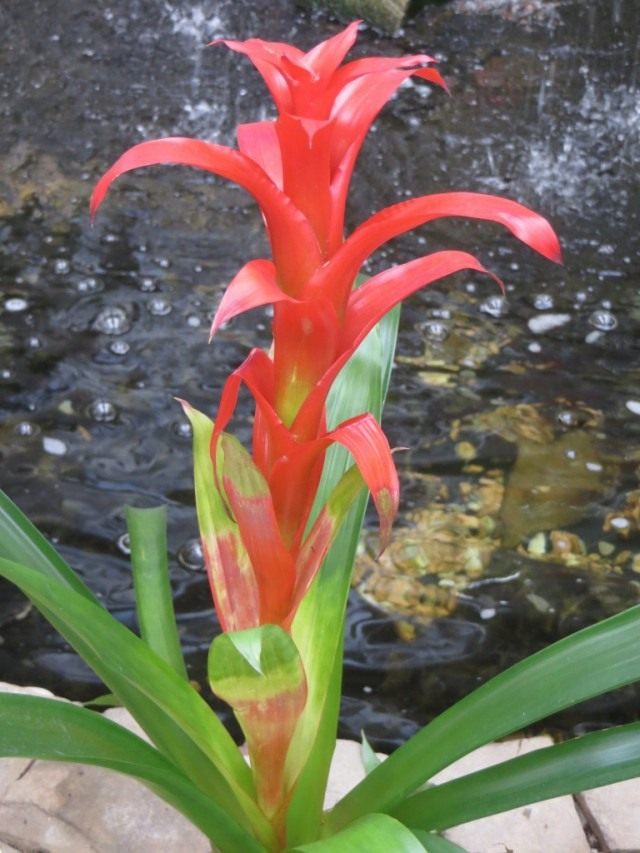 Gusmania
Gusmania
Before planting gusmania, the pot is half filled with drainage: (pebbles, expanded clay, pieces of broken dishes), which will protect the root system from waterlogging, which means from decay. Pour the prepared substrate from turf soil, sand, peat, humus on top (2: 1: 1: 1). For looseness, add chopped pieces of charcoal, needles and bark of conifers. The ideal soil mixture for gusmania is a store-bought soil for bromeliads or orchids.
It is better to transplant gusmania in the spring, while the substrate should not be strongly compacted. Depending on the conditions of keeping, new plants will bloom after 2-3 years. If the shoots are not separated from the mother plant, then the gusmania will bloom more magnificently, and reproduction will occur naturally.
Gusmania is transplanted annually, when the roots become cramped in a small pot. The capacity is taken a little large, but not too spacious. A small pot promotes rapid flowering.
Gusmania looks spectacular on a fancy snag, in a coconut shell or on a piece of bark from a balsa tree. The roots of the flower are wrapped in sphagnum moss, and then attached to the bark with wire. But when growing a flower in this way, you should be more responsible when it comes to watering, since such soil dries out very quickly.
Ways to stimulate the flowering of guzmania
Some growers cannot get new flowering from the purchased guzmania for a long time after the formation of young rosettes. You should not use any hormonal stimulants. To stimulate flowering, it makes sense to do the following:
- increase additional lighting;
- make fertilizing with fertilizers containing boron and phosphorus;
- increase the temperature around the plant to + 27C;
- normalize air humidity.
A small trick is also often voiced - placing pots of guzmania in a bag with apples for 2 weeks.It is believed that this stimulates them to throw out the peduncle. However, practice does not always confirm the effectiveness of this method.
 Guzmania do not need artificial stimulation for good flowering. It is enough to create optimal conditions for them for natural growth and the formation of young rosettes.
Guzmania do not need artificial stimulation for good flowering. It is enough to create optimal conditions for them for natural growth and the formation of young rosettes.
How to properly care for guzmania
Caring for a guzmania flower, and its transplanting at home, require certain knowledge. First of all, it is worth remembering that this is a thermophilic exotic beauty who prefers diffused light and high humidity. When the flowering period begins, the plant needs a temperature of at least 25 degrees, although 20 is enough for a flowering plant, the pus should be at least 13 degrees.
It is worth spraying in winter to a lesser extent, observing an interval of a day or two, the procedure is carried out in the morning, so that the moisture has time to evaporate by the evening. At the same time, water should not fall on the peduncle - this will significantly shorten the flowering period.
How to care for guzmania at home
Despite the different sizes, bracts and flowering periods, all guzmania require the same care. Of course, this is good news for those who want to decorate their home with several varieties of plants at once. By creating a favorable microclimate, you will not only save the flower from disease and pest infestation, but you will also be able to somewhat extend the period of its flowering.
Lighting
The indoor guzmania flower develops better in light partial shade, so if you placed it on the south window, take care of a protective visor. Prolonged exposure to direct sunlight damages the variegated leaves and saturated bracts, making them weak and dull. Experts recommend placing a flowerpot with bromeliads on the west or east windows. Once the plant is positioned on a north-facing window, be prepared that it may not bloom. In winter, the flower, as a rule, lacks sunlight, so you should transfer it to a bright room or provide additional lighting.

It is better to grow guzmania in an apartment away from direct sunlight
Temperature
In summer, guzmania grows well at normal room temperature of 22-25 ° C, which greatly simplifies its care. Please note that the plant loves well-ventilated rooms, but does not tolerate drafts. Bromeliad is a thermophilic plant, but prolonged increases in temperature and excessively dry air can cause the tips of the leaves to dry out. To avoid this problem, move the flowerpot to a cool place. In winter, the plant does not need additional heating, it feels comfortable even at a temperature of 15-20 ° C. It is not recommended to place it near heating devices and radiators.

It is better to grow guzmania away from the battery.
Humidity
Guzmania prefers to grow in a humid environment, so regular spraying is a must. It retains some of the moisture in a bowl-shaped socket, but in the summer heat, the water evaporates rather quickly. Spraying is carried out several times a week with clean, settled water from a special spray bottle. In summer, the number of spraying is increased, and with the onset of autumn, it is reduced. If the air temperature in the apartment is below 20 ° C, it is not recommended to humidify the air. In a cold room, excessive moisture can lead to decay of foliage and root systems.

Guzmania is a moisture-loving subtropical plant
How to water guzmania
One of the most common mistakes is watering guzmania at the root. This plant has a specific structure, so it should be watered directly into the outlet. It should be about two-thirds full with water. Use extremely clean, settled water at room temperature for moisturizing, otherwise the flower may get sick. During the spring and summer period, make sure that the outlet is filled with water.Once a month, it should be completely dried and the fluid should be replaced. If the room temperature drops below 10 ° C, the outlet should be dried so that the plant does not get a so-called "cold burn". The root system of Guzmania is very vulnerable, therefore it can suffer from over-watering.
In winter, the plant should be moistened with extreme caution.
Top dressing
Under natural conditions, guzmania practically does not receive nutrients from the environment, therefore feeding is not a decisive factor in its cultivation. As a rule, fertilizers are used to stimulate and increase the duration of flowering. From April to August, feeding is carried out monthly, and in the autumn-winter period it is carried out once every few months.
Bloom
Blooming guzmania is a real reason for pride, because sometimes it is not easy to achieve flowering. Note that charming bracts are formed only on an adult plant that has reached 3-5 years old. Only those flower growers who properly carry out home care will be lucky to see them. Bromeliad needs good lighting, abundant watering, regular feeding and frequent spraying, so carefully follow all agrotechnical recommendations. To speed up the formation of a beautiful inflorescence somewhat, place a small apple slice on the substrate near the plant and cover it with a plastic bag. Soon, the fruit will begin to release ethylene, which stimulates the guzmania to bloom.

Guzmania blooms only once in a lifetime
Guzmania mix: description of the plant, characteristics of varieties
Guzmania is an epiphytic evergreen perennial that in some cases can behave like an annual plant, that is, it blooms for only one season. Although the plant is native to the rainforests of South America, it has taken root well at home.
In indoor conditions, the leaves of the plant can reach 0.5-0.7 m. They are distinguished by a smooth structure, rather wide, and have a straight shape. Gathering together, the leaves of the plant form a bromeliad rosette, culminating in luxurious flowers.
An adult plant is capable of reaching a height of about 0.7-0.75 m, the crown diameter is almost the same as the height of the crop. At home, unfortunately, the guzmania is not able to achieve this size: its height does not exceed 0.35-0.4 m.
The flowering of the plant begins with the arrival of spring and ends by mid-autumn. At the same time, the flowers themselves look rather modest, but the inflorescences are distinguished by an incredibly exotic bright appearance: the rosette has a yellow-orange color and reaches a length of about 5 cm.
Under natural conditions, about 130 varieties and varieties of guzmania grow, but only a few of them take root well in indoor conditions:
Mosaic. In length, the leaves can reach 0.5 m. The color of the leaves is very unusual: dark green or brown transverse stripes flaunt brightly on them. Flowering begins in late winter (usually with the arrival of February). The inflorescences are very large and bright, the number of flowers in one can reach 20-25 pieces.
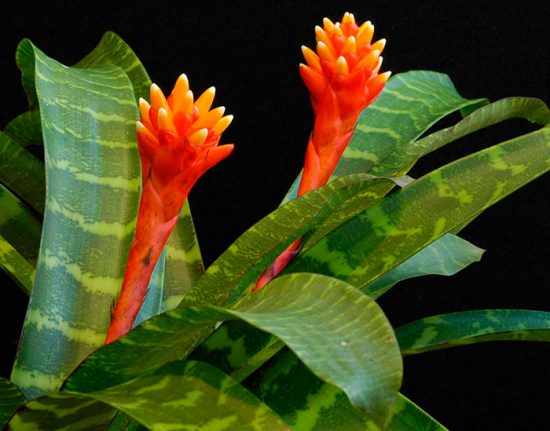 Mosaic
Mosaic
Reed. This variety is represented by a large number of varieties, among which Guzmania minor can be distinguished. This is a compact plant (in comparison with other varieties it is considered dwarf), during the flowering period it is covered with a large number of small small white flowers. Flowering begins with the arrival of winter / spring.
 Reed Guzmania, grade Minor
Reed Guzmania, grade Minor
Blood red. The leaves of the plant are distinguished by their decorative appearance: they form a kind of glass. Thyroid inflorescences usually consist of 10-12 small fiery red flowers.
 Blood red
Blood red
Donnatella-Smith. The leaves are rather unusual, with a scaly structure, forming a kind of loose rosette.
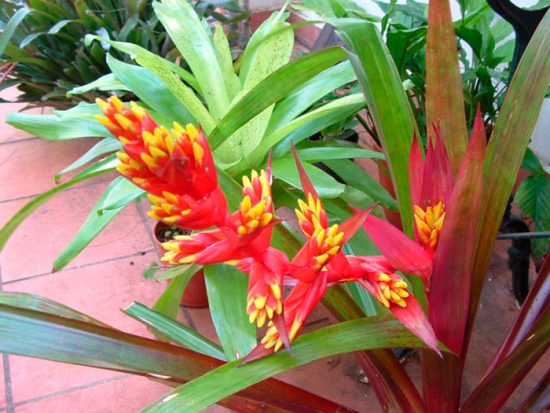 Donnatella-Smith
Donnatella-Smith
One-headed. The variety is distinguished by leaves of a yellow-green hue. The inflorescence is spicate, with a large number of white flowers. The flowers are pyramidal.Flowering lasts for two months in spring, starting in April.
 One-spiked
One-spiked
Care
To begin with, it is worth noting that among flower growers it is known that the guzmania mix is a plant that must be looked after quite carefully and carefully. Therefore, it is believed that the flower is quite difficult to grow. On the other hand, subject to all the necessary rules and recommendations, the Guzmania mix is quite actively developing and pleases households and guests with its attractive appearance.
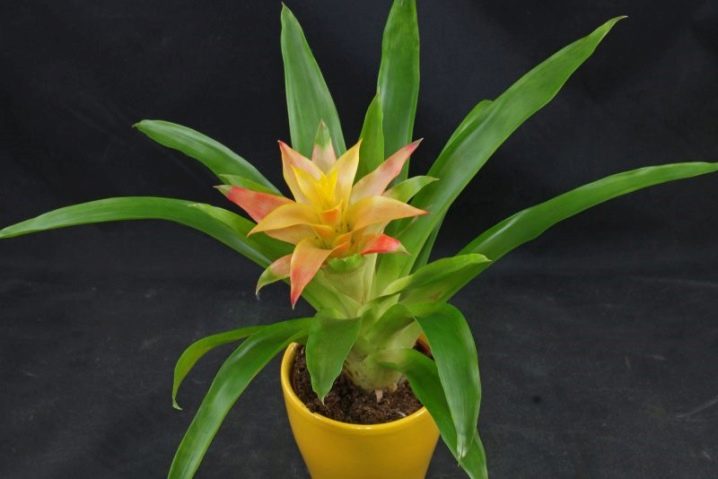
To begin with, it should be borne in mind that for irrigation it is allowed to use only warm water, which must first go through the settling process. The irrigation procedure itself is carried out by pouring water into the sockets. After a short period of time, the filled water must be drained. It is strictly forbidden to leave liquid - this can provoke decay processes, and, as a result, the death of the plant. The flower is moistened only in hot and dry seasons, characterized by low air humidity and high temperatures. The required frequency of watering is once every 2 days.
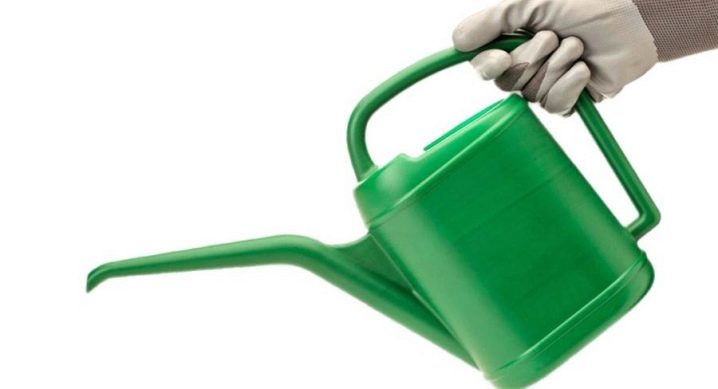
In addition to watering and moistening the soil, attention should be paid to other conditions for keeping the flower. So, due to the fact that guzmania mix is a tropical plant, it does not tolerate cold well
The optimal temperature regime of the room, which contains guzmania, should not be lower than 25 degrees Celsius.
The humidity indicator deserves no less attention. To maintain it, you can use special humidifiers, spray the leaves of the plant with water, or keep the guzmania in rooms with high humidity (for example, a bathroom, a kitchen).
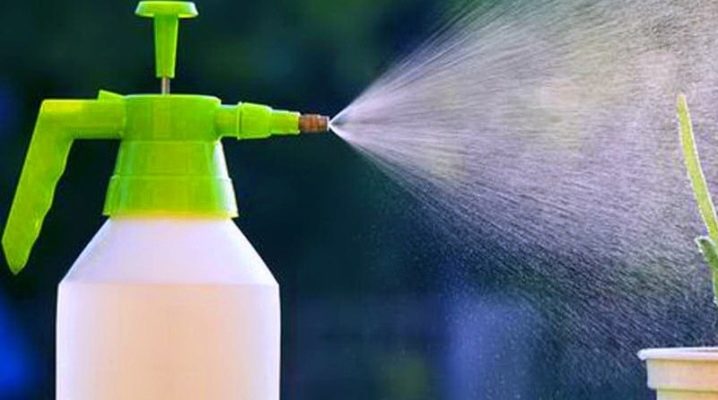
As for lighting, first of all, it is worth considering that the flower does not tolerate direct rays of the sun, preferring partial shade. That is why it is forbidden to keep the plant on the windowsill - direct sunlight can cause burns on the leaves. On the other hand, in winter the plant needs a certain amount of light, so it is advised to use a variety of artificial lighting options.

Guzmania also needs fertilizers. Feeding is especially necessary in the warm season (spring and summer). Such a seasonal need is explained by the fact that during this period the plant blooms, accordingly, spends a large amount of its strength and energy. Botanists advise using ready-made mixtures as top dressing, which can be found and bought at any flower shop. In particular, a fertilizer complex designed for bromeliad-type plants would be an ideal option. Fertilization schedule - once every 2 weeks.
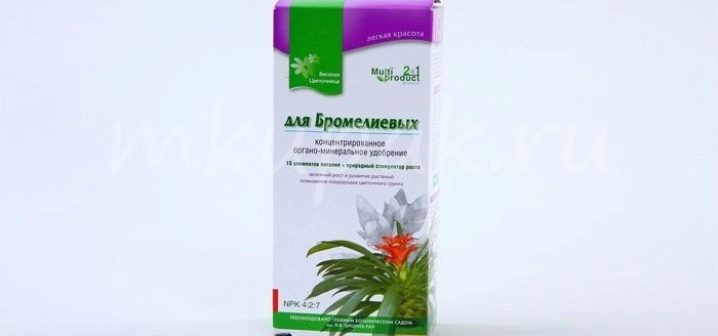
Features of care for gusmania
Lighting for gusmania
Gusmania can be grown in a bright or shaded place. She prefers diffused light, from direct sunlight at noon it should be shaded, for example, with translucent paper or cloth. Grows well on west or east windows. Grows well on northern windows, but may not bloom. In the summer, gusmania can be taken out into the open air, but it should be protected from sunlight, rain and drafts. If you do not have the opportunity to place the plant outdoors in the summer, then you should regularly ventilate the room.
In the autumn-winter period of gusmania, good lighting is needed; during this period, shading is not required. Additional lighting can be created using fluorescent lamps, placing them above the plant at a distance of 50-60 cm, for at least 8 hours a day. In the autumn-winter period, it is also necessary to ventilate the room, but drafts should be avoided.
Gusmania watering and air humidity
During the growing season (from March to October), gusmania is watered abundantly, as the soil dries up. Water is poured into the outlet funnels, preferably in the morning. The water must be changed periodically in the funnels.Before the onset of the dormant period after the flowering of the gusmania, the water is drained from the outlet. In winter, watering is moderate, with a content below + 20 ° C, water is not poured into the funnels, but the plant is sprayed.
Plants placed on a bromeliad tree are removed from the support at least 1 time in 10 days and immersed in settled water until saturated, after which excess water is allowed to drain and returned to its place.
Water for watering gusmania is used well-settled and soft, 2-3 degrees above room temperature.
If the plant is kept above + 20 ° C in winter, you can occasionally pour a small amount of water into the outlet, only in the morning and always warm.
Like all bromeliads, gusmania prefers high humidity. Growing in a terrarium or a humid greenhouse is optimal for her. It is necessary to spray the plant several times a day. To increase moisture, the plant can be placed on a pallet with damp moss, expanded clay or pebbles. In this case, the bottom of the pot should not touch the water. You should periodically wipe the leaves of gusmania with a damp cloth, cleaning them from dust, the use of a special wax to make the leaves shine is not desirable.
From May to August, gusmania fertilizers are carried out once a month, while the fertilizer is diluted with water for irrigation and poured into an outlet. Fertilizer is used special for bromeliads or for ordinary indoor plants, but taken in a dose four times less than for other plants. It must be remembered that the dose of nitrogen in the fertilizer should be low, its excess can cause the death of the plant.
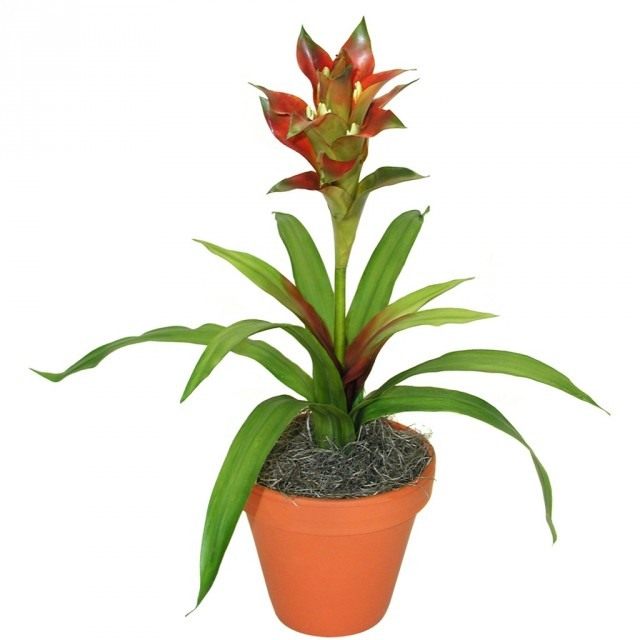 Gusmania, cultivar "Scarlet Star"
Gusmania, cultivar "Scarlet Star"
Gusmania transplant and substrate
Gusmanias are transplanted as needed, 1 time every 2-3 years. During transplantation, the neck of the plant is not buried; this can cause the plant to rot and die.
The substrate for growing gusmania should be porous, drainage should be at least 1/3 of the height of the pot. For epiphytic species, the mixture is made up of crushed pine bark, chopped sphagnum, high peat, leafy, humus soil (or dry mullein) in a ratio of 3: 1: 1: 1: 0.5 with the addition of perlite and pieces of charcoal.
For terrestrial species of gusmania, a substrate is prepared from leafy, humus earth, peat and sand (2: 1: 1: 0.5). Sphagnum, sod land, bark of coniferous trees, and charcoal are used as additives. The planting container should not be too deep, it is better to use wide bowls.

